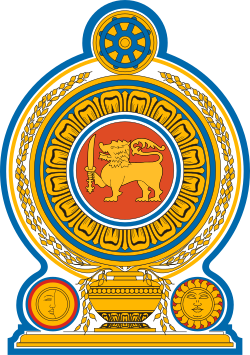| Emblem of Sri Lanka ශ්රී ලංකාවේ ජාතික ලාංඡනය இலங்கையின் தேசிய சின்னம் | |
|---|---|
 | |
| Armiger | Democratic Socialist Republic of Sri Lanka |
| Adopted | 1972 |
| Crest | A Dharmachakra azure on a bezant |
| Shield | On a circular shield: Maroon, a lion passant Or bearing a Sri Lankan sword Or in its right forepaw; an orle enhanced azure bearing concentrically from the center outwards two annulets argent, the petals of a golden water lily proper, and an annulet Or; a bordure Or |
| Supporters | Golden symbols of the Sun and the Moon; the stalks of rice growing from the vase surrounding the shield |
| Compartment | A traditional grain vase |
| Other elements | An annulet or passing under the crest and vase surrounding the stalks of rice; a bordure azure surrounding the entire arms |
The National Emblem of Sri Lanka [1] [2] [3] is used by the State of Sri Lanka and the Government of Sri Lanka in connection with the administration and government of the country. The current emblem has been in use since 1972 and created under the ideas and guidance of Nissanka Wijeyeratne. At the time, he was Permanent Secretary to the Ministry of Cultural Affairs and Chairman of the National Emblem and Flag Design Committee. [4] The designer of the emblem was Venerable Mapalagama Wipulasara Maha Thera, [5] [6] [7] [8] [9] [10] [11] [12] [13] and the artwork was by S. M. Seneviratne.
Contents
- History
- Portuguese period in Ceylon
- Dutch period in Ceylon
- British Ceylon
- Dominion of Ceylon
- Sri Lanka
- Historical coats of arms
- See also
- References
- External links

The emblem features a gold lion passant, holding a sword in its right fore paw (the same lion from the flag of Sri Lanka) in the centre on a maroon background surrounded by golden petals of a Blue Lotus the national flower of the country. This is placed on top of a traditional grain vase that sprouts sheaves of rice grains that circle the border reflecting prosperity.
The crest is the Dharmachakra, symbolizing the country's foremost place for Buddhism and just rule. Traditional Sinhalese heraldic symbols for the sun and the moon form the supporters. Sun and Moon, and Lion depicting Buddha is given less prominence than cart wheel of English Buddhism, so it is in great discordance with National Scriptures.[ citation needed ]



